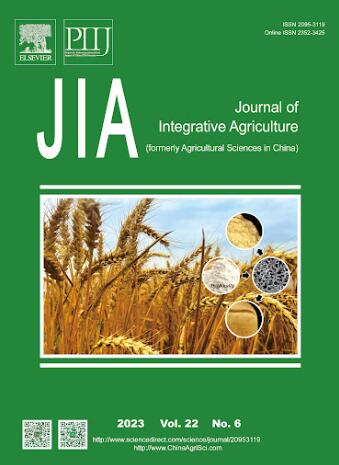研究反应调节器 GlrR 和 ArcA 在嗜线虫 Xenorhabdus CB61 中异胭脂虫肽生物合成过程中的调控作用
IF 4.4
1区 农林科学
Q1 AGRICULTURE, MULTIDISCIPLINARY
引用次数: 0
摘要
Xenocoumacins (Xcns)是由Ⅳ产生的主要抗菌天然产物,因其在作物保护中的潜在应用而受到广泛关注。然而,人们对参与 Xcns 生物合成的调控机制仍然知之甚少。在这项研究中,我们通过生物信息学分析在 CB6 中发现了 21 个潜在的双组分系统(TCS)。其中,反应调节因子(RRs)GlrR和ArcA通过基因缺失和互补实验被证明能正向调节Xcns的产生。此外,我们的研究结果表明,GlrR 在细胞生长中发挥着重要作用,而 ArcA 则同时参与细胞形态和生长。利用多种分子生物学和生物化学技术,我们发现 GlrR 通过间接调节生物合成基因簇(BGC)的表达水平来控制 Xcns 的生物合成。ArcA直接与Xcns BGC的启动子区域结合并调控其转录,其结合位点也被确定。这项研究为了解 Xcns 生物合成的调控网络提供了宝贵的信息,有助于构建高产菌株。本文章由计算机程序翻译,如有差异,请以英文原文为准。
Studying of the regulatory roles of response regulators GlrR and ArcA in xenocoumacins biosynthesis in Xenorhabdus nematophila CB61
Xenocoumacins (Xcns), the major antimicrobial natural products produced by , have gained widespread attention for their potential application in crop protection. However, the regulatory mechanisms involved in the biosynthesis of Xcns remain poorly understood. In this study, we identified 21 potential two-component systems (TCSs) in CB6 by bioinformatic analysis. Among them, the response regulators (RRs) GlrR and ArcA were proven to positively regulate the production of Xcns based on gene deletion and complementation experiments. In addition, our results showed that GlrR played an important role in cell growth, while ArcA was involved in both cell morphology and growth. Using a variety of molecular biological and biochemical techniques, we found that GlrR controlled the Xcns biosynthesis by indirectly regulating the expression levels of the biosynthetic gene cluster (BGC). ArcA directly binded to the promoter regions of and to regulate the transcription of the Xcns BGC, and the binding sites were also identified. This study provides valuable insights into the regulatory network of Xcns biosynthesis, which will contribute to the construction of a high-yielding strain.
求助全文
通过发布文献求助,成功后即可免费获取论文全文。
去求助
来源期刊

Journal of Integrative Agriculture
AGRICULTURE, MULTIDISCIPLINARY-
CiteScore
7.90
自引率
4.20%
发文量
4817
审稿时长
3-6 weeks
期刊介绍:
Journal of Integrative Agriculture publishes manuscripts in the categories of Commentary, Review, Research Article, Letter and Short Communication, focusing on the core subjects: Crop Genetics & Breeding, Germplasm Resources, Physiology, Biochemistry, Cultivation, Tillage, Plant Protection, Animal Science, Veterinary Science, Soil and Fertilization, Irrigation, Plant Nutrition, Agro-Environment & Ecology, Bio-material and Bio-energy, Food Science, Agricultural Economics and Management, Agricultural Information Science.
 求助内容:
求助内容: 应助结果提醒方式:
应助结果提醒方式:


